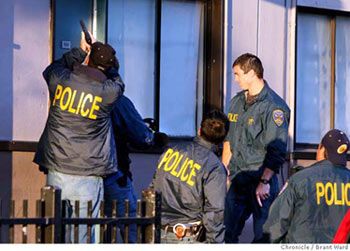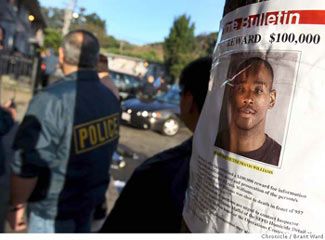| The relationship between the media and law enforcement is often adversarial. Reporters appear to seek the sensational elements of a crime story, often to the detriment of the police, and officers tend to be uncooperative with journalists they seem to instinctively mistrust. Not so with “The Badge,” a new series presented by a San Francisco Chronicle reporter/photographer team embedded with the SFPD. Kudos to the Chronicle for pursuing this series and to the officers who willingly put themselves in the media spotlight in the hopes of helping civilians develop a better understanding of life behind the badge. You’re putting a human face on “the police,” which will benefit us all. |
By John Koopman
The San Francisco Chronicle
Related: Getting it right: The importance of pre-raid planning
In the early morning light, just before dawn, 30 cops assemble outside the police station in San Francisco’s Ingleside district.
They load weapons, strap on body armor, check radios, pull on windbreakers that say “Police” in big yellow letters.
 An SFPD officer uses a 30-pound battering ram to knock in a door at the Alemany housing projects while other police officers draw their weapons in search for alleged drug dealers. San Francisco Chronicle photo by Brant Ward |
There’s an FBI agent, a U.S. marshal, and from the San Francisco Police Department there are 10 members of the Gang Task Force, a dozen more from the Fugitive Recovery Enforcement Team, narcotics officers and some uniformed officers from the Ingleside Station.
There’s going to be a raid. The cops are looking for a couple of alleged drug dealers in the Alemany housing projects. Informants have said there are guns in the homes, so there’s a heightened sense of tension.
The sun peeks over the hill at Candlestick Point to the east, casting Ingleside in a warm glow.
“Somebody’s going to jail today,” predicts Lt. Ernie Ferrando, head of the Gang Task Force.
This all started weeks earlier, when narcotics officers conducted an operation in the Alemany projects. Undercover officers went into two apartments on Ellsworth Street to buy drugs. They didn’t make any arrests, but brought the information back for further action.
 A reward poster, asking for information about a recent homicide, is near the area of the police raid. San Francisco Chronicle photo by Brant Ward |
The cops secured arrest and search warrants for the two residents, who live in apartments next to each other. Warrants are listed as “day service” or “night service,” indicating the time of day they may be served. You cannot search a home at night if the warrant says “day service.”
Day service starts at 7 a.m., which is why the officers gathered at the Ingleside Station at 6:30 a.m. The thinking is, most people are still asleep at 7 a.m. If they’re sleepy and bleary-eyed, there’s less chance they might be ready to fight, or be high on drugs.
Going to a drug house is a high-risk operation. You never know what’s on the other side of that door.
Drug sting aside, there’s another reason for the raid: Violence has spiked recently in the Ingleside area. The Police Department wants to send a message, and it will be delivered by cops with guns and battering rams.
“I suppose it’s a little like being a dad,” Ferrando says. “The kids have been bad. It’s time for Dad to step in and settle things down.”
The police line up their cars along the road leading to the station. Simultaneously, they rev their engines and roar out into the neighborhood. It’s a short drive to Alemany, but this is San Francisco. Even cops on a big drug raid have to deal with commute traffic on Interstate 280. They dodge and weave and honk at other drivers, to stay together for the final drive in the projects.
Off the freeway, on Alemany, the cars gun toward their objective. A couple of blocks from the target, the enforcement team peels off and heads toward the homes of other bad boys, guys who are fugitives or on felony parole or probation.
The main group of cars stops short in front of a run-down building on Ellsworth. Groups of officers approach each door, separated by 15 feet or so. The team to the left knocks loudly on the door. “Police!” they yell. “We have a search warrant!”
The door opens, and the men rush inside.
The other team doesn’t fare so well. No one responds to the knock.
A cop hefts a handheld battering ram. It weighs about 30 pounds. He twists to his right, then swings the ram with all his might to the left, smacking the door to the right of the doorknob.
It doesn’t make a dent.
He swings again. And again. And again.
Thwack. Thwack. Thwack. The battering ram hits the door five, six, seven, eight times. The officer pauses for a moment to catch his breath, then resumes the battering.
“They’ve got a lot of time to flush their stash,” Ferrando says. What seems like two minutes of incessant pounding is probably closer to 30 seconds. Finally, the door frame buckles and the door is open.
But what, or who, is inside? The first cop in will find out, one way or another.
The cops rush in, one right behind the other, like a big blue clump.
Ferrando, in command of the operation, stands outside his car, monitoring radio traffic and waiting, wondering if his guys are all right inside.
“OK, Code Four,” he announces and relays that to dispatch. Everything is all right in the two apartments. No guns, no fights, no problems.
Now people from other units have come outside to see what’s going on. A half-dozen people, mostly women and kids, hang out in their front yards and watch the raid.
The housing units are two stories, like townhouses. Neighbors on either side of the raided homes peer out from their second-floor windows.
The cops are coming out of the two apartments. At one unit, the person named in the warrant is not home. The police find nothing inside. No guns. No drugs. They do find gang graffiti, though. Some of it links a young man the cops know to a local gang. With the city attorney’s office turning more and more to civil injunctions to help break up gangs, this is considered a good haul for the morning.
The people in the apartment are miffed that they had early morning guests.
“What gives you the right to come in here and mess up my house?” one woman demands of a carload of cops as they prepare to leave.
She says she doesn’t know the person named in the warrant. An older man echoes her comments, saying, “We got kids coming in and out of here all the time.”
At the home with the now-broken door, three people are led out in handcuffs. They sit on the front stoop while the officers search the house. No guns are found, but the cops do find a small amount of drugs.
One man is led into a car. He’s on his way to jail.
Copyright 2007 The San Francisco Chronicle

